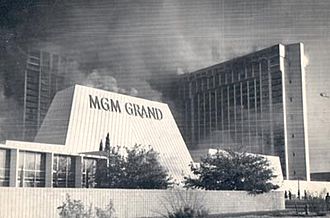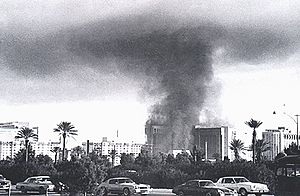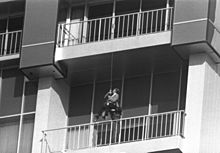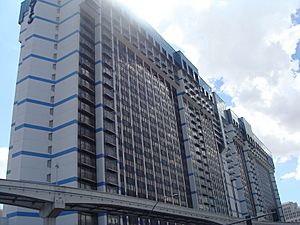MGM Grand fire facts for kids
 |
|
| Date | November 21, 1980 |
|---|---|
| Venue | MGM Grand Hotel and Casino |
| Location | Paradise, Nevada, U.S. |
| Type | Fire |
| Cause | Electrical ground fault caused by electrical receptacle |
| Deaths |
|
| Non-fatal injuries |
|
The MGM Grand fire happened on Friday, November 21, 1980, at the MGM Grand Hotel and Casino in Paradise, Nevada. This hotel is now known as Horseshoe Las Vegas. The fire sadly killed 85 people, mostly because they breathed in too much smoke.
The fire started from a refrigerated pastry display case in one of the restaurants on the first floor. The fire quickly spread through the casino, and smoke filled the hotel tower. This event is still the deadliest disaster in Nevada's history. It is also the third-deadliest hotel fire in modern U.S. history. This terrible incident led to big changes in fire safety rules and building codes in Nevada.
Contents
The MGM Grand Fire Incident
About 5,000 people were inside the MGM Grand when the fire started. This huge building had a casino and a 26-story hotel with over 2,000 rooms. It had opened just seven years earlier in 1973.
At about 7:07 AM on November 21, 1980, a fire began in a restaurant called The Deli. A construction worker noticed a flickering light, which turned out to be a wall of flames. Another hotel employee saw smoke coming from the ceiling vents just before the lights went out.
Emergency Response and Rescue Efforts
MGM security quickly called the Clark County Fire Department (CCFD). The first fire engine arrived just two minutes after the call. Soon, many other fire departments joined in, including those from North Las Vegas, Las Vegas, and Henderson.
A massive helicopter rescue effort took place. Helicopters from Nellis Air Force Base helped save about 1,000 people from the hotel's roof. These helicopters included UH-1N (Hueys) and CH-3E (Jolly Green Giants).
The fire quickly spread through the casino floor. It was fueled by things like wallpaper, PVC piping, glue, and plastic mirrors. Within six minutes, the entire casino floor was on fire. A huge fireball even burst out of the main entrance facing the Las Vegas Strip. The fire spread fast in areas where there were no fire sprinklers. Eighteen people died on the casino level.
The fire itself stayed mostly on the first floor. However, the burning materials created dangerous smoke and toxic fumes. These fumes traveled up through the hotel tower using elevator shafts, stairwells, and seismic joints. This caused most of the deaths. More than 200 firefighters worked to put out the fire. They found it hard to move through the dark, smoke-filled areas.
Challenges During Evacuation
Evacuating guests was difficult because the elevators did not automatically return to the main floor during a fire. Ten people were found dead in an elevator. Some guests tied bedsheets together to try and escape from their balconies or to signal for help. Fire ladders could only reach up to the ninth floor.
Some people broke their windows to get fresh air. However, this often let in even thicker smoke from outside. Falling glass from broken windows was also a danger to people below. A construction worker used a scaffolding platform to help lower guests to the ground. The Barbary Coast casino across the street became a safe place for MGM guests to go.
What Caused the Fire?
The fire was limited to the casino and restaurant areas. The hotel did have a fire sprinkler system in some parts, which helped keep the fire from spreading further in those areas. The place with the most fire prevention was the money counting room, not the guest rooms or casino floor.
The fire was caused by an electrical problem. It started from an electrical outlet inside a wall.
How the Electrical Fire Started
A refrigerated pastry display case had been added to The Deli restaurant after the hotel was built. This display case had pipes that carried refrigerant, similar to an air conditioner. These pipes were installed through the same wall space as existing electrical wires.
The fan unit in the display case vibrated constantly. These vibrations caused the refrigerant pipes to rub against the electrical wires. Over time, this rubbing, along with a process called Galvanic corrosion (where two different metals touch and cause one to wear away), damaged the electrical wires. The plastic insulation on the wires wore off, leaving bare wires. The electrical system also lost its proper grounding.
These bare electrical wires became very hot and started sparking. This caused the fire to ignite. The fire likely smoldered for hours before it found enough oxygen and burst into flames, spreading into the casino.
How Smoke Spread
The hotel's ventilation system played a big part in spreading the smoke. Faulty smoke dampers in the air ducts allowed toxic fumes to circulate throughout the hotel. The ventilation system kept running, which made the smoke problem worse.
On the casino floor, there was no way for the smoke to escape. So, the ventilation system pushed it into the hotel tower. The smoke quickly filled the hotel's telephone room. Operators there only had time to warn people on the casino floor before they had to evacuate. This meant hotel guests were not warned about the fire. Also, the elevator shafts were located above the restaurant and casino, which helped the smoke spread upwards. Some guests had propped open fire doors in stairwells, which also allowed more smoke to spread.
Why Sprinklers Weren't Everywhere
Sprinklers were installed on the first two floors and the top floor of the hotel. However, the casino and restaurants did not have sprinklers. This was because they were exempt from rules requiring sprinklers in areas open 24 hours a day. A building inspector in Clark County allowed this exception. The idea was that a fire would be quickly noticed by people and put out with fire extinguishers.
However, The Deli restaurant was closed when the fire started. Even though some sprinklers were in the hotel, they were not near where the fire began. A full sprinkler system for the entire hotel would have cost about $192,000. Because of the cost, MGM only installed the minimum number of sprinklers required by law when the hotel was built.
After the Fire
The MGM Grand hotel had to close temporarily because of the fire. The casino was badly damaged and charred. The hotel hallways and stairwells were covered in soot and smoke.
The closure of the MGM Grand affected Nevada's gaming income, as it was a major tax contributor. The county lost about $1.7 million, and MGM Grand Hotels faced a potential $1 billion loss.
Rebuilding and Safety Improvements
The MGM Grand was rebuilt over the next eight months. It cost $50 million to repair and upgrade. The hotel reopened in July 1981 with many new fire safety features. These included fire sprinklers and an automatic fire alarm system throughout the entire building.
A special computer system was installed to monitor hundreds of locations in the hotel, helping to prevent future fires. The Las Vegas MGM now had over 30,000 sprinklers, with four in most hotel rooms. It also had 8,000 speakers, one in each room, to give fire safety instructions to guests.
The air-conditioning system was changed to stop smoke from entering rooms. Large exhaust fans were added that could clear fumes from the hotel in 10 minutes. Plastic pipes and wires that made the fire worse were removed. A five-minute fire safety video, hosted by Gene Kelly, was played on hotel room televisions. Hotel officials believed the MGM was now the safest hotel in the world.
A small incident happened two weeks after the reopening. Some insulation started to smolder because of a welder's torch. The new automatic alarms worked perfectly, showing the improvements were effective.
The original hotel tower, where most deaths occurred, is still in use today. A second tower opened in 1981. In 1986, the MGM Grand was sold to Bally Manufacturing, which changed its name to Bally's Las Vegas. A new MGM Grand hotel opened in Las Vegas in 1993.
New Fire Safety Rules
Within a week of the fire, the governor of Nevada created a group to decide if older hotels should follow newer fire safety rules. Just 81 days after the MGM fire, another fire happened at the Las Vegas Hilton, killing eight people.
Because of these two fires, there were big changes to fire safety rules and building codes. All public buildings in Nevada were required to have fire sprinklers, smoke detectors in rooms and elevators, and exit maps in all hotel rooms. This law started in 1981, making Nevada a leader in fire safety. It took several years for all buildings to follow these new rules.
Legal Actions After the Fire
More than 1,350 legal claims were filed because of the fire. Many lawsuits were filed against MGM, asking for a lot of money for damages. MGM made many settlement deals with the victims in 1983. In 1985, a $76 million settlement was reached between MGM and insurance companies. By 1998, there was $440,000 left from the MGM victim settlement. This remaining money was given to fire and burn victims in Clark County.
See also
 In Spanish: Incendio en el MGM Grand para niños
In Spanish: Incendio en el MGM Grand para niños




